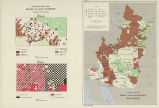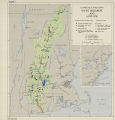| OCR Text |
Chapter 4 Economics and Financing of Projects The Rio Grande Basin is unique in several eco- nomic and financial aspects of water resources de- velopment. Rehabilitation of existing projects cre- ates a special problem in this basin in financing the replacement and modernization program. Exces- sive sedimentation increases project costs and makes necessary additional programs. Power production is subordinate to use of water for irrigation, and there is a relatively small amount of power and a small allocation of joint costs to this function. Under current practices of the Bureau of Reclama- tion, there is a small repayment of irrigation invest- ment from power revenues. As a consequence of the advanced deterioration of lands and facilities in many areas, repayment of reimbursable phases of many needed programs constitutes a difficult financial problem. Development Program as a Whole This analysis is limited to construction programs of the Bureau of Reclamation and the Corps of Engineers having to do only with rehabilitation of the physical land base. The cost estimates for var- ious projects are those submitted by the reporting Federal agencies. Costs incurred by the construc- tion program of the International Boundary and Water Commission are not analyzed in this discus- sion. Other programs, including the flood control activities of the Department of Agriculture, are not evaluated. A full discussion of economic aspects cannot be made until all programs are presented. The total estimated construction cost of Federal water development programs, including existing projects, projects under construction, and author- ized, in the Rio Grande Basin is 233.5 million dol- lars, all Federal except the small amount of $269,000. Of this total the largest single item is for irrigation, for which the total cost allocation is 116.1 million dollars. Some of this has been repaid and presumably most of the total amount eventually will be repaid without interest by the water users. Only 3.4 million dollars of the amount allocated to irrigation is to be repaid from power revenue. The only other reimbursable cost is the allocation to power of approximately 6 million dollars which will be repaid, with interest, from power revenues. The total reimbursable costs for irrigation and power equal about 53 percent of the total costs. The total cost allocated to flood control is about 50 million dollars, all Federal except $269,000. No costs have been allocated to sediment control, but, on the basis of physical allocation of space to trap sediment in Jemez Canyon and Chamita Reservoirs, 13.4 million dollars would be the proportionate cost of the works used for this purpose. There is a proposed allocation of 50.4 million dollars to "protection from drought hazards" in the Valley Gravity Project which would be nonreim- bursable. Slightly over 1 percent of the total estimated cost of the program has been allocated to recrea- tion and fish and wildlife. More specifically, 3.4 million dollars has been allocated to these purposes, with the amount divided almost equally between the recreation program and fish and wildlife pres- ervation. These costs are nonreimbursable. And finally, 2 million dollars have been allocated to mis- cellaneous nonreimbursable purposes. Several other projects with favorable benefit-cost ratios have been analyzed but not authorized; these are an irrigation project with estimated costs of 4.5 million dollars (Balmorhea), a flood and sedi- ment trapping project with estimated costs of 32.8 million dollars (Chiflo), and a conveyance channel 313 |


























































































































































































































































































































































































































































































































































































































































































































































































































































